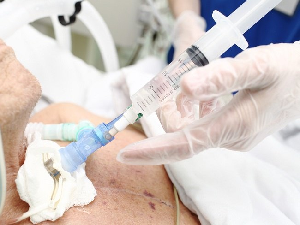
Ching Feng Huang, Ya Fang Zhuang, Jiaxuan Liu, Chee Kiang Tay, Duu Wen Sewa
European Respiratory Journal 2020; DOI: 10.1183/13993003.02173-2020
We read with interest a research letter by Ng et al., which described their experience in prone positioning (PP) for awake patients with COVID-19 pneumonia, and concluded that this maneuver could delay or reduce the need for intensive care. We agree that the authors demonstrated safety and feasibility of PP in COVID-19 pneumonia patients. However, we humbly suggest a few crucial points be addressed before drawing conclusions on the efficacy of PP.
First, the median time from illness onset to starting oxygen therapy (OT) and awake PP was 9 and 11 days respectively. In a JAMA study by Young et al. – colleagues of Ng and co-authors, 6 out of 18 COVID-19 patients received OT as their oximetry saturations (SpO2) were <92%, and median time from symptom onset to OT initiation was 4 days. Two among these 6 patients eventually needed intensive care for worsening respiratory failure. However, they had contrasting clinical trajectories, particularly in relation to tempo and extent of deterioration. The first patient desaturated at day 3, with rapid declining oxygenation that necessitated mechanical ventilation (MV) by day 8 while the second only developed hypoxia later at day 10 of illness. Although the latter was admitted to intensive care 3 days later, the patient needed at most venturi mask 50% and was successfully weaned by day 20 of illness. By referencing local data, it is plausible that most patients in Ng's series were at low risk of developing severe COVID-19 pneumonia prior to awake PP.
Second, there was considerable patient heterogeneity in regard to severity of hypoxemia. Unreported information, e.g. chest radiology, protocol to guide PP management limit data interpretation. COVID-19 pneumonia is increasingly recognised to manifest phenotypic diversity, rather than a strict dichotomy i.e. phenotype L and H. Moreover, PP's physiologic effects would only benefit phenotype H i.e. typical ARDS, as characterised by predominantly dorsal consolidation and poor respiratory compliance. Studies on PP in non-intubated ARDS patients pre-dating COVID-19 reported oxygenation improvement but there was no demonstrable improvement in clinical outcomes. There was however, an increased risk of death attributed to delayed intubation in severe ARDS regardless of choice/combination of adjunct therapies e.g. noninvasive ventilation/high flow nasal therapy (HFNT).
Third, all but one patient had SpO2>90% on room air at OT initiation. SpO2≥90% is an ATS/IDSA 2007 criterion for clinical stability in hospitalised patients with community acquired pneumonia. Current guidelines do not recommend OT in acute myocardial infarction and stroke patients with SpO2 90–92% as evidence on its potential harm continues to emerge. Similarly, we recommend judicious use of OT as hyperoxia could exacerbate cytokine release syndrome (CRS) – the main immunopathological driver implicated in severe coronavirus infections. It is regretful that Ng's study did not define indications for OT, which could explain the remarkably discrepant intubation rates (10% versus 60%) of COVID-19 pneumonia patients treated at the same center.
Finally, we would like to share our experience on using awake PP and HFNT (PP+HFNT) in 3 patients since late April 2020. They were managed with the strategy below:
-
A. Inclusion criteria
-
SpO2<92% on intranasal oxygen ≥6 L·min−1 or venturi mask 50%; or PF ratio <200
-
Considerable bilateral opacities on chest radiograph i.e. compatible with degree of hypoxemia
-
Respiratory rate <30 breaths·min−1
-
Not using accessory muscles of respiration i.e. sternocleidomastoids
-
No contraindications to PP e.g. cervical spine instability, pregnancy, etc.
-
-
B. Maneuver
-
- Four 2-hour sessions of PP daily
-
-
C. Termination criteria
-
ROX index persistently <4.88 despite optimising HFNT and/or worsening clinical status requiring intubation
-
Patient's inability to tolerate PP
-
All 3 patients required OT to keep SpO2>92% by one week of illness. Patients were at day 13, 16 and 8 of illness when PP+HFNT was started. The first two required 5 and 2 days of PP+HFNT while the last was intubated for worsening hypoxemia after 4 days. Our observations echo those in Young's study. Just as the importance of personalised MV strategies cannot be overemphasised in COVID-19 ARDS, we maintain that selecting the appropriate patient subgroup for awake PP on OT is equally crucial. While we await more data, we opine that awake PP may work in hypoxic COVID-19 whereby the trajectory in oxygenation deterioration is less precipitous – meaning CRS is more indolent (thus causes ARDS over a longer time span), or already abating (the worst is over). Development of a prognostic model derived from clinical, laboratory and physiologic data may predict risk of severe hypoxemia requiring mechanical ventilation and guide personalised treatment in COVID-19 pneumonia.
TABLE 1
Patient characteristics and parameters trends on PP+HFNT
Footnotes
-
Conflict of interest: Ms. Huang has nothing to disclose.
-
Conflict of interest: Ms. Zhuang has nothing to disclose.
-
Conflict of interest: Dr. Liu has nothing to disclose.
-
Conflict of interest: Dr. Tay has nothing to disclose.
-
Conflict of interest: Dr. Sewa has nothing to disclose.
- Received June 5, 2020.
- Accepted June 22, 2020.
- Copyright ©ERS 2020














